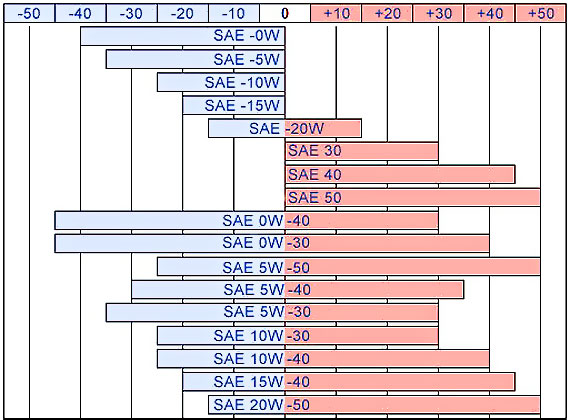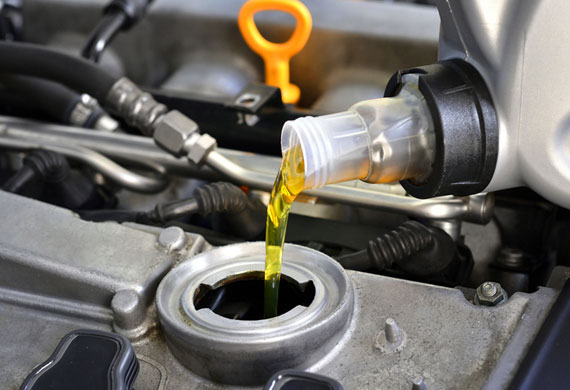How to choose motor oil by viscosity
What is the viscosity of the oil? This is one of the key quality indicators, common to all types of oils. It is responsible for the thickness of the oil and can change significantly, depending on the temperature. Therefore, it is very important that the oil is sufficient viscosity, allowing to provide lubrication of rubbing parts and mechanisms in a wide range of temperatures.
In this article, we explain in a simple and understandable language, what is the viscosity of the oil, as it changes depending on the temperature, to which parameters it affects, and which means the numbers in the designation of the oil viscosity by SAE.
What are the numbers in the designation of the oil viscosity (decoding)

The viscosity of the oil is the parameter that on the package is indicated by the letters of SAE. Those times have long passed when viscosity could determine the mineral oil, semi-synthetic or synthetic. Motorists with experience, for sure, still remember when SAE oil was asked on the market. Then it was all easy and simple: 15W-40 - mineral water, 10W-40 - semi-synthetic, and 5W-40 - synthetics.
Today everything is different. You can easily find semi-synthetic 15W-40 or 10W-40 synthetics, especially in the cargo segment. What do all these numbers and letters mean? Let's deal with the order.
According to the classification of SAE oil, it is customary to divide on the winter (with the index "w"), summer and all-season. Standard viscosity parameters for winter and summer oils are indicated as follows:
- Winter oils: SAE 0W, 5W, 10W, 15W, 20W;
- Summer oils: SAE 30, 40, 50.
All-season oils have a mixed specification, that is, they combine both winter and summer viscosity parameter, divided in the designation sign of the dash: SAE 0W-30, 0W-40, 5W-30, 5W-40, 5W-50, 10W-30 , 10W-40, 15W-40, 20W-50.
As you probably have already guessed, almost all oils presented to date on sale are all-season and have a mixed specification.
So we got directly to decrypt what the figures of the viscosity of the oil. In the designation of viscosity on SAE, the numbers mean the following:
- The first digit (winter parameter), for example, 0W - indicates the minimum temperature of the safe cold start. This means that the smaller the first digit, the oil is calculated on the lower temperature.
- The second digit (summer parameter) indicates the possibility of using oil under certain temperature conditions.
There is a myth that the numbers of the summer oil viscosity parameter - mean the temperature of the maximum allowable environment at which the car is possible. For example, oil with a viscosity of 5W-30 is calculated at the temperature of +30 ° C. It is not true! These figures do not have any relationship to the ambient temperature. Remember, the summer parameter is the numbers conditional and they have nothing to do with the environment.
A table with the ranges of oil applications by SAE, depending on the temperatures, see below.
The dependence of the viscosity of the oil from temperatures

Oddly enough, not only the possibility of using oil in a specific temperature range, but also the life of its service, and, accordingly, the periodicity of the replacement depends on viscosity. What is it connected with? Read on.
The necessary viscosity of oil provide viscosity additives. They are long synthetic chains that have a different surface tension from two sides. The lower the temperature, they are more folded into the "tangle" and provide the necessary oil fluidity at minus temperatures.
In descriptions to engine oils, they often write: "provides an even easier engine start at low temperatures." This is the very ability of viscous additives to turn into "tangle".
And how does the oil viscosity change when the temperature is raised? In this case, the "tights" of viscous additives, on the contrary, unfold into the chains and, arbitrarily focusing throughout the volume of oil, provide high viscosity at high temperatures.
The length of the chains of viscous additives depends on the viscosity of the oil: the greater the range between the winter and summer parameter, the chain is longer. Moreover, if you compare the length of the oil chain of 5W-30 and 5W-40, it will be longer at times (not percent, and at times).
The longer the chain, the smaller amount of folding and unfolding it is designed. After a certain number of repetitions, these chains begin to collapse, the oil loses its viscosity and requires replacement. That is precisely from the length of this chain basically, the oil replacement interval depends.
Of course, other additive packages have a great influence on the frequency of oil replacement. But we will talk about it next once, and now we will not consider it.
Remember the main thing: The greater the range between the winter and summer parameters of the viscosity of the oil, the less the interval of its replacement. And vice versa.
We give one indicative example. More recently, in some dealer centers during the warranty service in cars, 5W-50 oil was flooded with 15,000 km of run, motivating the fact that it was a cool modern oil created for sports modes.
Yes, it is really cool modern oil, and it is created specifically for sports modes. But it is not designed for 15,000 km. It needs to be changed in five, well, a maximum of six thousand runs, because the viscosity chain is long, and it will begin to collapse just through these 5-6 thousand km. Have this in mind.

On the pages of this site, we have already raised the question of which oil is better to pour into the engine. But there it was about technology (synthetics, semi-synthetic, mineral water). And now we will dwell on the choice of oil from considerations of its viscosity.
The most truthful information about your car is in the service book. What viscosity oil is indicated there, it must be applied. Moreover, from the first replacement to the last.
There is an opinion that the older the car, the point of the motor oil in it you need to pour. This is not quite true. Rather, truth, but not for everyone.
Firstly, There are a number of engines (for example, 16 valve Ford ZeTec), in which oil can only be filled with a viscosity of 5W-30. So, in such engines, even the oil with a viscosity of 5W-40 can only be used for the topping.
This is due to the constructive features of such engines that have long and thin lubricant channels. The oil pump is more difficult to sell thick oil through such channels, and the motor can operate under oil starvation (especially in winter and at startup). And this leads to increased wear of rubbing parts and a decrease in the motor test.
SecondlyMany cars in the service book indicate two viscosities. Here are from them and choose. Consciously go on the thickening of the oil can only be checked after checking the status of the engine and consulting with a motorist. As a rule, these are cases when the engine requires repair, and you are not ready to repair it for a number of reasons. In this case, you can extend the "agonia" of the motor, going to more viscous oils.
In other cases, if the engine is in order and all systems associated with it, in order - fill the oil with the characteristics recommended by the manufacturer of the car, and your Iron horse will live happily and happy.














